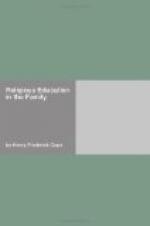In beginning a lesson it will be wise to call to mind first the principle running through the book, that the great work of the family is the development of religious persons in the home; then call to mind the application of this principle in the last lesson. Make your review very brief.
Next, bring out the leading topic of the lesson for the day. This should be done so as to present a vital issue and a live topic to the class. Very often the best way of doing this is to state a concrete case involving the issue discussed. The presentation of a definite set of circumstances or a fairly complete experience involving the fundamental principles under discussion is an instance of teaching by the “case method.” If the teacher will consider how the law student is trained by the study of particular cases, the advantage of the method will be clear. Be sure that the “case” selected will include the principles to be taught. Prepare the statement of the case beforehand. This should be done in a very brief narrative, so giving the instance as to enable the class to see the reality of the question. Be sure that your instance is itself vital and probable. A class of adults will especially need such points of vital contact. By announcing the topic in advance the teacher will often be able to obtain definite cases in point from the members.
With the case thus presented take the points in the text and apply them, first to the special case alone, but with the purpose of developing the principles involved in that and similar cases. Beware of the special danger of the case method, namely, that the class may discuss the specific instances rather than the principles.
Teaching is more than telling; it is stimulating other minds to see and comprehend and state for themselves. Therefore the teacher must first comprehend and be able to state for himself. Avoid repeating the phrases of the text. Get them over into your own language and see that the class does the same. Do not fail to call for the brief reports on reading, and to make them a real part of the subject of discussion.
Questioning is the natural method of stimulating minds. Use the question method, but do not confine yourself to “What does the author say on this?” Direct your questions to the points stated and the issues raised so as to compel students to think on the topics and so as to draw out the results of their thinking. Form your own judgments and help the class to form theirs too. Remember that the purpose of the class is to get people thinking on the great subjects discussed. The text is not written in order that groups of students may learn the author’s statements, but that they may be led to think seriously on all these matters and stimulated to do something about them.
Use the “discussion topics” given at the end of each lesson. They are not designed to furnish a syllabus of the lesson, but to suggest important questions for discussion, some of which may barely be mentioned in the text. They may be used in assigning the advance work, giving topics to different students, and they may be used in your review of the previous lesson.




